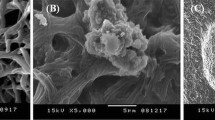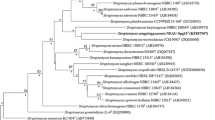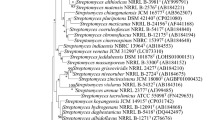Abstract
A new actinomycete strain designated MITKK-103 was isolated from the soil of a flowerpot using a humic acid agar medium. The newly isolated strain was able to produce a large amount of actinomycin X2 even under nonoptimized growing conditions and serves as a promising source of this antibiotic. Actinomycin X2 has higher cytotoxicity toward cultured human leukemia (HL-60) cells than does actinomycin D, and it induces cell death via apoptosis. A nearly complete 16S ribosomal DNA (rDNA) sequence from the isolate was determined and found to have high identity (98.5–100%) with Streptomyces galbus, Streptomyces griseofuscus, and Streptomyces padanus, indicating that MITKK-103 belongs to the genus Streptomyces. The isolate clustered with species belonging to the S. padanus clade in a 16S-rDNA-based phylogenetic tree and showed 75% overall homology to S. padanus ATCC 25646 in DNA–DNA relatedness analysis. Although the growth of the isolate was somewhat different from the three species mentioned, the strain MITKK-103 most closely resembles S. padanus on the basis of the morphological and phenotypic characteristics, phylogenetic analysis, and genotypic data. As such, this is the first report of a strain of S. padanus capable of producing actinomycins.






Similar content being viewed by others
References
Alekhova TA, Novozhilova T (2001) Biosynthesis of polyketide antibiotics by various actinomycin producing Streptomyces species. Prikl Biokhim Mikrobiol 37:309–316
Altschul SF, Madden TL, Schaffer AA, Zhang J, Zhang Z, Miller W, Lipman DJ (1997) Gapped BLAST and PSI-BLAST: a new generation of protein database search programs. Nucleic Acids Res 25:3389–3402
Anderson AS, Wellington EM (2001) The taxonomy of Streptomyces and related genera. Int J Syst Evol Microbiol 51:797–814
Baldacci E, Farina G, Piacenza E, Fabbri G (1968) Description of Streptomyces padanus sp. nov. and emendation of Streptomyces xantophaeus. G Microbiol 16:9–16
Bolognese A, Correale G, Manfra M, Lavecchia A, Mazzoni O, Novellino E, Barone V, Pani A, Tramontano E, La Colla P, Murgioni C, Serra I, Setzu G, Loddo R (2002) Antitumor agents. 1. Synthesis, biological evaluation, and molecular modeling of 5H-pyrido[3,2-a]phenoxazin-5-one, a compound with potent antiproliferative activity. J Med Chem 45:5205–5216
Bossi R, Hutter R, Keller-Schierlein W, Neipp L, Zahner H (1958) Metabolic products from actinomycetes. XIV. Actinomycin Z. Helv Chim Acta 41:1645–1652
Brosius J, Palmer ML, Kennedy PJ, Noller HF (1978) Complete nucleotide sequence of a 16S ribosomal RNA gene from Escherichia coli. Proc Natl Acad Sci U S A 75:4801–4805
Castillo UF, Strobel GA, Ford EJ, Hess WM, Porter H, Jensen JB, Albert H, Robison R, Condron MA, Teplow DB, Stevens D, Yaver D (2002) Munumbicins, wide-spectrum antibiotics produced by Streptomyces NRRL 30562, endophytic on Kennedia nigriscans. Microbiology 148:2675–2685
Chen FM, Sha F, Chin KH, Chou SH (2004) The nature of actinomycin D binding to d(AACCAXYG) sequence motifs. Nucleic Acids Res 32:271–277
El-Gammal AA (1987) Characterization of an orange-brown pigment-antibiotic produced by Streptomyces viridiviolaceus. Egypt J Microbiol 21:37–42
El-Naggar MYM (1998) Synergistic effect of actinomycin X2 produced by Streptomyces nasri YG62 with other antibiotics. Biomed Lett 58:169–173
Ezaki T, Hashimoto Y, Yabuuchi E (1989) Fluorometric deoxyribonucleic acid–deoxyribonucleic acid hybridization in microdilution wells as an alternative to membrane filter hybridization in which radioisotopes are used to determine genetic relatedness among bacterial strains. Int J Syst Bacteriol 39:224–229
Farber S, D'Angio G, Evans A, Mitus A (2002) Clinical studies of actinomycin D with special reference to Wilms' tumor in children. 1960. J Urol 168:2560–2562; discussion 2563
Frommer W (1959) Zur Systematik der actinomycin bildenden streptomyceten. Arch Mikrobiol 32:187–206
Green DM (1997) Paediatric oncology update/Wilms' tumour. Eur J Cancer 33:409–418
Guo J, Wu T, Bess J, Henderson LE, Levin JG (1998) Actinomycin D inhibits human immunodeficiency virus type 1 minus-strand transfer in in vitro and endogenous reverse transcriptase assays. J Virol 72:6716–6724
Gupta KC, Sobti RR, Chopra IC (1963) Actinomycin produced by a new species of Streptomyces. Hindustan Antibiot Bull 6:12–16
Ha SC, Hong SD (1994) Identification of the actinomycete strain No.1372, a producer of actinomycin X2. Sanop Misaengmul Hakhoechi 22:164–168
Hirata Y, Nakanishi K (1949) Actinomycin J2, a by-product from a strain of Actinomyces. Bull Chem Soc Jpn 22:121–127
Jacobson E, Dstwald W (1942) The color harmony manual and how to use it. Color Laboratories Division, Chicago
Kataoka M, Ueda K, Kudo T, Seki T, Yoshida T (1997) Application of the variable region in 16S rDNA to create an index for rapid species identification in the genus Streptomyces. FEMS Microbiol Lett 151:249–255
Kleeff J, Kornmann M, Sawhney H, Korc M (2000) Actinomycin D induces apoptosis and inhibits growth of pancreatic cancer cells. Int J Cancer 86:399–407
Kurzatkowski W (1975) Role of Streptomyces melanochromogenes cell wall and membrane in actinomycin D biosynthesis. Med Dosw Mikrobiol 27:325–336
Lam KS, Gustavson DR, Pirnik DL, Pack E, Bulanhagui C, Mamber SW, Forenza S, Stodieck LS, Klaus DM (2002) The effect of space flight on the production of actinomycin D by Streptomyces plicatus. J Ind Microbiol Biotechnol 29:299–302
Malpartida F, Hallam SE, Kieser HM, Motamedi H, Hutchinson CR, Butler MJ, Sugden DA, Warren M, McKillop C, Bailey CR et al (1987) Homology between Streptomyces genes coding for synthesis of different polyketides used to clone antibiotic biosynthetic genes. Nature 325:818–821
Marmur J (1961) A procedure for the isolation of deoxyribonucleic acid from micro-organisms. J Mol Biol 3:208–218
Marroquin AS (1959) Actinomycin A from Streptomyces globosus. Rev Soc Quim Mex 3:19–22
Mauger AB (1980) The actinomycins. Ellis Horwood, England
Men'shikov GP, Denisova SI (1962) Isolation of actinomycins from the group Actinomyces fluorescens. Antibiotiki 7:31–32
Mossman T (1983) Rapid colorimetric assay for cellular growth and survival: application to proliferation and cytotoxicity assays. J Immunol Methods 65:55–63
Onaka H, Taniguchi S, Igarashi Y, Furumai T (2002) Cloning of the staurosporine biosynthetic gene cluster from Streptomyces sp. TP-A0274 and its heterologous expression in Streptomyces lividans. J Antibiot (Tokyo) 55:1063–1071
Pernodet JL, Boccard F, Alegre MT, Gagnat J, Guerineau M (1989) Organization and nucleotide sequence analysis of a ribosomal RNA gene cluster from Streptomyces ambofaciens. Gene 79:33–46
Pirt SJ, Pickett SMA, Pickett AM, Vandamme EJ, Bird CW (1981) Antibiotics from the newly isolated Streptomyces elizabethii. J Chem Technol Biotech 167–177:167–177
Rill RL, Hecker KH (1996) Sequence-specific actinomycin D binding to single-stranded DNA inhibits HIV reverse transcriptase and other polymerases. Biochemistry 35:3525–3533
Roos GHP, Loane C (2004) A clarifying NMR study of actinomycin X2. J Saudi Chem Soc 8:289–294
Saitou N, Nei M (1987) The neighbor-joining method: a new method for reconstructing phylogenetic trees. Mol Biol Evol 4:406–425
Shih HD, Liu YC, Hsu FL, Mulabagal V, Dodda R, Huang JW (2003) Fungichromin: a substance from Streptomyces padanus with inhibitory effects on Rhizoctonia solani. J Agric Food Chem 51:95–99
Shirling EB, Gottlieb D (1966) Methods for characterization of Streptomyces species. Int J Syst Bacteriol 16:313–340
Shirling EB, Gottlieb D (1968) Cooperative description of type cultures of Streptomyces. III. Additional species descriptions from first and second studies. Int J Syst Bacteriol 18:279–392
Takusagawa F, Carlson RG, Weaver RF (2001) Anti-leukemia selectivity in actinomycin analogues. Bioorg Med Chem 9:719–725
Thompson JD, Higgins DG, Gibson TJ (1994) CLUSTAL W: improving the sensitivity of progressive multiple sequence alignment through sequence weighting, position-specific gap penalties and weight matrix choice. Nucleic Acids Res 22:4673–4680
Wadkins RM, Vladu B, Tung CS (1998) Actinomycin D binds to metastable hairpins in single-stranded DNA. Biochemistry 37:11915–11923
Waksman SA, Woodruff HB (1940) Bacteriostatic and bacteriocidal substances produced by soil actinomycetes. Proc Soc Exp Biol Med 45:609–614
Wayne LG, Brenner DJ, Colwell RR, Grimont PAD, Kandler O, Krichevsky MI, Moore LH, Moore WEC, Murray RGE, Stackebrandt E, Starr MP, Trüper HG (1987) Report of the Ad Hoc Committee on reconciliation of approaches to bacterial systematics. Int J Syst Bacteriol 37:463–464
Williams WK, Katz E (1977) Development of a chemically defined medium for the synthesis of actinomycin D by Streptomyces parvulus. Antimicrob Agents Chemother 11:281–290
Womer RB (1997) Soft tissue sarcomas. Eur J Cancer 33:2230–2234; discussion 2234–2236
Zhou C, Wu Y, Dong L, Ye H, Wu J (1999) Studies on the mutation and fermentation of Hainanmycin producing strain. Zhongguo Kangshengsu Zazhi 24:11–13
Acknowledgements
This work was funded in part by the Government of Malaysia and the Malaysia-MIT Biotechnology Partnership Programme. We would like to thank Dr. Jacqueline Piret for helpful suggestions on the manuscript.
Author information
Authors and Affiliations
Corresponding author
Rights and permissions
About this article
Cite this article
Kurosawa, K., Bui, V.P., VanEssendelft, J.L. et al. Characterization of Streptomyces MITKK-103, a newly isolated actinomycin X2-producer. Appl Microbiol Biotechnol 72, 145–154 (2006). https://doi.org/10.1007/s00253-005-0240-2
Received:
Revised:
Accepted:
Published:
Issue Date:
DOI: https://doi.org/10.1007/s00253-005-0240-2




